What do I really need to show off my long-awaited abs? How long does it take to get a six-pack? Where do I start? Well, you've come to the right place, because in this post I want to tell you everything. No lies, no magic recipes. So you don't waste your time unnecessarily and reach your goal sooner. From an honest source and with the right knowledge is how you get things done. You have already taken the first step: you have the motivation to look for the information you need and you have come to us. Now it's time to read and then put into practice what you are going to learn here!
The first thing I want to make clear to you is that showing off your abs is a purely aesthetic issue. You can be perfectly healthy and functional without showing your abs. However, we understand that we all love to show off at the beach and pool and sometimes we look to take our fitness one step further. There's nothing wrong with that. Defined abs have appealed to us since childhood, as all our favorite superheroes had them. Getting them to show is a lot easier than people think. As I say, it's more a matter of having the right knowledge and consistency for a few months with abdominal exercises and diet. Let's get started!

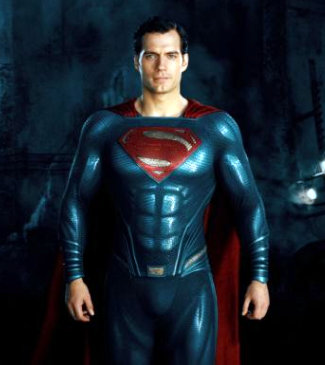
If you're here, let me guess that right now you probably don't mark your abdomen. You'd like to look defined but don't know where to start. The first step is to determine why your abdomen is not defined or "marked" and that can be due to several reasons.
WHY DON'T MY ABS LOOK DEFINED DESPITE DOING ABDOMINAL EXERCISES?
In order of relevance...
1.- You have to reduce abdominal fat: and this can only be achieved by reducing the percentage of total body fat in your body. We cannot decide in which part of our body we eliminate fat. Our fat reserves are used up progressively from all our deposits (we lose fat from the face, legs, arms, etc.). By burning fat in a general way, we will also reduce the fat we are interested in: abdominal fat.
Now, how much fat do we have to burn? In men, the abs are visible when their total body fat percentage is close to 12% or 10%.
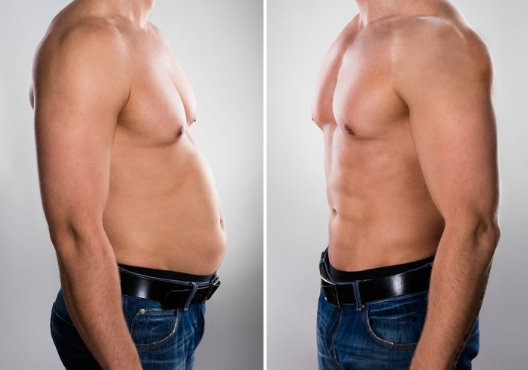
Marking abs is not just about slimming down. It's not going from being overweight to being lean or fit, it's going beyond that. It's bringing your fat levels below average. To give you an idea, most men you see on the street have between 15% and 20% body fat. A healthy and adequate level of fat but not enough to uncover the tablet. For example, a 6'4", 75 kg guy with a visible six pack (at 10% fat) would have to have as little as 7.5 kg of body fat.
We usually underestimate the amount of fat we have on our bodies. Even if you look slim, you should know that most average men with a normal lifestyle may have to lose 8-10 kg of fat to see a well-sculpted abdomen.
In girls, the abdomen is marked at around 15% body fat. This is because women distribute fat differently than men and biologically need more reserves.
Now you know that the number one reason you can't see them is that there may be fat covering them.
2.- The other case is when you are thin and even your body fat percentage is low. You look flat but still your abs are not chiseled or drawn. Don't panic! In this case, what happens is that you lack abdominal development. You need to strengthen your abdominal muscles. This is usually the typical case of people who are thin but, at the same time, very untrained. The abdomen, like any other muscle in the body, requires work and movement so that it can gain size, density and strength. The good thing is that this muscle, as soon as you start exercising, immediately responds well. Rare is the athlete of any discipline that does not have strong abs.
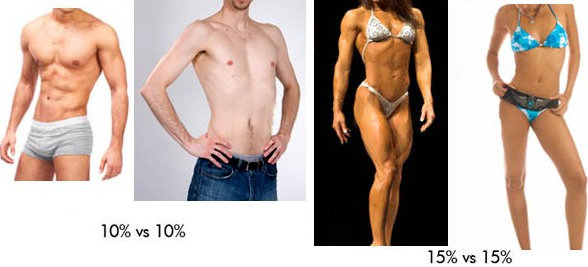
Surely you've heard the famous phrase "abs are made in the kitchen", and although we believe that reducing fat through diet is very important, we also believe that we must have a strong and developed muscles to show once we remove that fat.
Ideally, we should do both: both reduce abdominal fat and exercise to strengthen the abdominal muscles. In this guide you are going to learn what we consider to be the best machines and exercises to work the abs. We will divide the content into three parts:
1.- Abdominals Recommended machines to work them.
2.- Ideal abdominal exercises to sculpt your abs.
3.- How to reduce your fat percentage to show them.
ABDOMINAL MACHINES TO DO THEM
Look here for effective and defined abs. Surely you want to know what is the best machine that can work the abs. We are going to detail which ones we recommend making a distinction between those that you can find in a commercial gym and those that you can use at home.
PROFESSIONAL ABDOMINAL MACHINES
If you are joining a gym, you will surely find some of the following machines.
MACHINE ABDOMINAL CRUNCH: I recommend this one for being simple and effective. You just have to sit on the seat, grab the handles and perform the crunches. The interesting thing is that you can add weight progressively. Muscle grows when exposed to overload and the abdominals are no exception. They can be used by anyone. They are usually very safe machines and work the entire rectus abdominis.
The crunch machine exercise can be performed on plate-loaded machines or in its weight disc version.
|
|
Abdominal crunches with a professional plate-loaded machine. | This is another similar model for discs. |
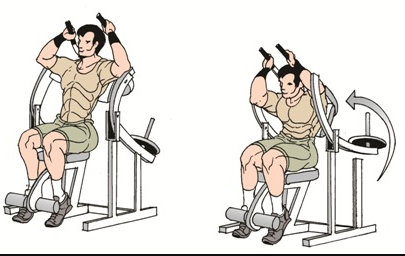
ABDOMINALS OBLIQUES MACHINE: any machine that allows waist twists. There are even plate-loading machines to add more resistance to the exercise. They strengthen the lateral area of the abdomen. The so-called obliques.
|
|
Professional waist turning machine with loads. | Non-weighted waist twisting apparatus for home use. |
ABDOMINAL BENCH: the ideal support to perform crunches / crunches free form. You can find it in any commercial gym. The benches incorporate a support to keep the legs fixed and to be able to lift the torso safely. They mainly work the upper abdominal muscles. We can increase the intensity of this exercise by holding a disc against the chest while performing the shrug.
|
Example of a professional incline bench to work on the abdomen with crunches. |
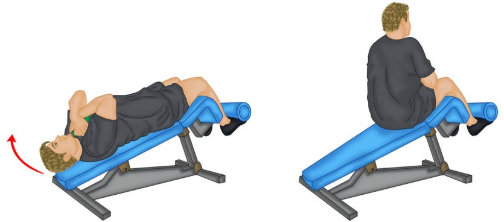
LOWER ABDOMINALS ON LOWER BACKS/DOMINATES MACHINE: you have probably seen it in many gyms. It is a machine to do free exercises with body weight (such as chest presses or pull-ups). The interesting thing is that these machines usually incorporate a padded backrest to rest the back and armrests with hand grips. In this way, the machine allows you to perform leg and knee crunches from a very comfortable position. This is one of the exercises I recommend as it is one of the most effective for strengthening the lower abdomen. It can be performed by bending the knees or with straight legs (which is much more difficult).
|
|
Example of a professional machine for pull-ups, abdominal and parallel pull-downs. | Example of a semi-professional or home machine for pull-ups, abdominal and pull-downs. |
MOBILE ABDOMINAL BENCH: this type of bench is also articulated. It has a grip for the hands and the bench moves with each crunch we perform. In this way, it makes the abdominal exercise more comfortable and achieves a movement similar to the machine crunch.
|
A mobile abdominal bench. |
|
Performing the abdominal exercise on a mobile bench with weighted discs. |
LUMBAR BENCHES: we include these benches because the lumbar back is the antagonist muscle of the rectus abdominis. If you work one, you should not neglect the other. We recommend that for each set of crunches you perform a corresponding set of lumbars. Perform hyperextensions on a bench. Avoid muscle decompensation! It is important that rectus abdominis and lumbar strength are well balanced. Lumbar benches can be straight or incline.
|
|
Lumbar hyperextension exercise. | A professional version of this bank. |
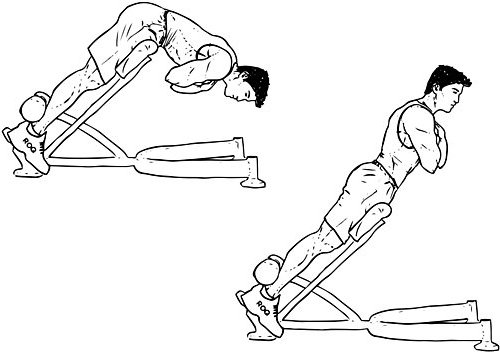
ABDOMINAL MACHINES AND OTHER HOME ABDOMINAL MACHINES
Other interesting abdominal machines and accessories that are also highly recommended for home use / training at home.
THE ABDOMINAL WHEEL: abdominal exercises are highly recommended. They are performed by grabbing this special wheel. To perform the exercise, do the following:
- We start from the initial position kneeling on the floor.
- We extend the whole body forward as if we wanted to do a plank, extending the arms as far as possible. We try to bring the wheel as far away from the body as possible.
- Once we are completely stretched out, we go back to the initial position, bringing the wheel back to our knees.
For beginners, it is not necessary to extend the arms completely. Only as far as you can reach.
Advanced users can perform the exercise starting from a standing position, which is a much more complicated variant.
The wheel strengthens the abdomen but also the entire musculature of the body such as the back and arms.
|
An abdominal wheel. |
|
Without a doubt, it is one of the most effective abdominal exercises. |
FITBALL AND BOSU BALLS: they are very typical of gymnastics and functional training. These accessories are also frequently used in group classes. They allow you to perform all kinds of shrugs and various movements. The interesting thing about working with these accessories is that they not only strengthen the abdominal muscles, but also the stabilizers, thus improving our balance.
The bosu ball or balance ball. |
|
This is a fitball or gymnastic ball. As we can see, it can also be used as an accessory for abs. |
DOMESTIC ABDOMINAL BENCHES AND APPLIANCES: they are used to perform crunches at home. We can find domestic abdominal benches and also apparatus for doing crunches on the floor.
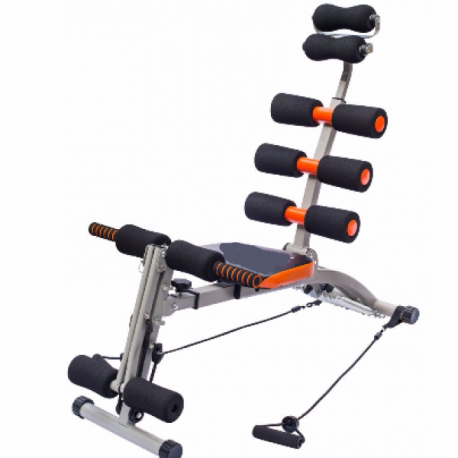
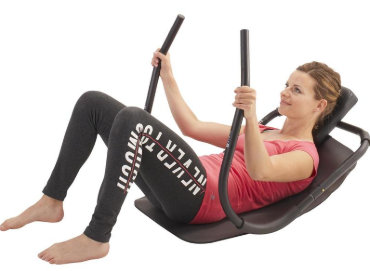
MATS: it is essential to have some of these to perform simple movements on the floor, such as torso crunches to exercise the upper area or leg lifts for lower abs.
|
Such a mat is very inexpensive and is perfect for core training at home (and stretching). |
MEDICINAL BALLS: they are also very useful for weight crunches and abdominal exercises in pairs.
|
Medicine ball. |
|
The medicine ball is effective for the exercise shown for oblique abdominals. |
TRX: the famous suspension training straps used by the United States Marines. Among the exercises you can do with them are the static planks, shrugs, leg lifts in suspension, etc.. They are very useful and valid for training anywhere.
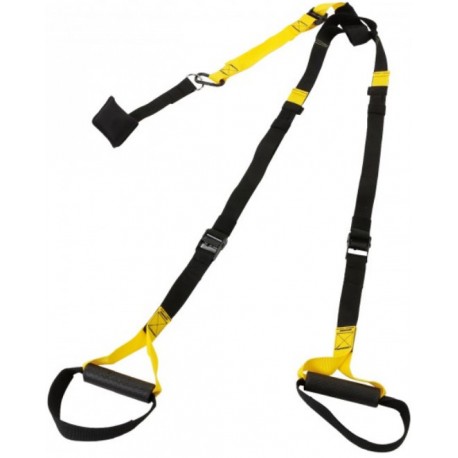
Now you can choose a machine that can work your abs. In the part below, we will explain some basic exercises and others not so well known so that you can finish strengthening your six-pack abs.
SCULPT YOUR ABS WITH EXERCISES
Apart from the aforementioned machine crunches, the most basic way to exercise the abdominal core is through free abdominal exercises performed with our own body weight.
BASIC MOVEMENTS
PUNCHES / CRUNCHES ON THE GROUND: the simplest exercise for the upper area. On a mat or mat, we keep our knees bent and the soles of our feet, buttocks, back and back of the head glued to the floor. Lift the torso in a shrugging motion, using abdominal strength, and try to bring the head towards the knees.
The hands can remain on both sides of the head or crossed on the chest.
It is advisable to take the air when lowering the torso and expel it when going up.
It is important to mentally focus the work on the abdomen. We avoid performing the movement by using the neck or lower back.
This exercise can be performed on a trellis with a board if available.
|
|
LEG RAISES FOR LOWER ABDOMINALS: for the lower area, the most basic movement is leg raises on the floor. On a mat, lie on your back, keeping the back of your head, back, arms and legs in contact with the floor. The hands can be placed behind the buttocks if desired. We can keep our gaze towards the tips of our toes. We take a breath and take our legs off the floor lifting them as much as our flexibility allows and keeping them straight. We expel the air as we come up. We lower our legs, slowly and in a controlled manner, feeling the work in the lower abdomen. We make sure that the legs do not touch the floor in the lowest part of the movement before starting the next repetition.
This exercise can also be performed on a trellis with a plank, to give a greater inclination.
Want to know more exercises for lower abs? That part that is so hard to develop. HERE YOU WILL FIND A FEW PRACTICAL EXERCISES courtesy of the Personal Trainer 24 website.
|
|
GROUND SHRUNCHES / CRUNCHES FOR OBLIQUES: performed in exactly the same way as the normal floor shrugs, but this time we try to bring the torso closer to the left or right knee on each repetition. Locate the work on the lateral part of the core.
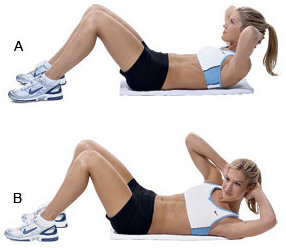
VERY EFFECTIVE AND LESS KNOWN MOVEMENTS
HANGING LEG RAISES: this is one of my favorites and I recommend it 100%, although it requires a certain level of experience.
You have to hang, for example, from a pull-up bar and stay suspended. You will have to catch your breath and push your legs up as close to your torso as possible. We expel the air as we go up.
You can do it with bent knees (easier) or with straight legs (more difficult).
It is an excellent exercise to strengthen the muscles with special emphasis on the lower abdominals.
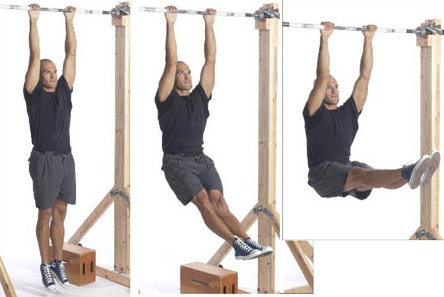
FULL CONTACT ABDOMINALS: this is another of the best abdominal exercises, widely used in contact sports training / fighting. To perform it, all you need is a barbell with a disc.
One end of the bar is placed on the floor. We grab with our hands the other end where the disc is placed.
We start with our hands up grabbing the bar above our head and take the end to our hips with a twist at the waist. To the left side of the hip and to the right, successively.
This complete exercise works the entire rectus abdominis and is a great core strength enhancer.
We can use heavier weights as we progress.
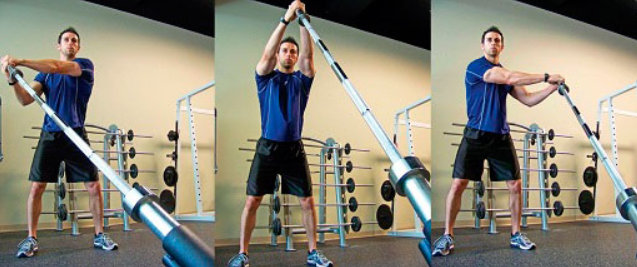
LATERAL TORSO FLEXION WITH HANDLEBAR (FOR OBLIQUES): to do this exercise, we must separate the legs shoulder-width apart and leave them slightly bent. With one hand we have to hold a dumbbell and the other hand we place it behind the head or on the hip. That would be the initial position.
We take a breath. Then, while releasing it, we contract our abdomen through a trunk flexion movement towards the side where we do not have the dumbbell.
We return in a controlled manner to the starting position to perform another repetition.
We do first one side and then the other.
We try to localize the work in the oblique avoiding unnecessary impulses. We do not lean the trunk forward or backward.
We work mainly the oblique and rectus abdominis muscles.
We can increase the difficulty of this exercise by performing it on a BOSU BALL. This way, it will be more difficult to balance.
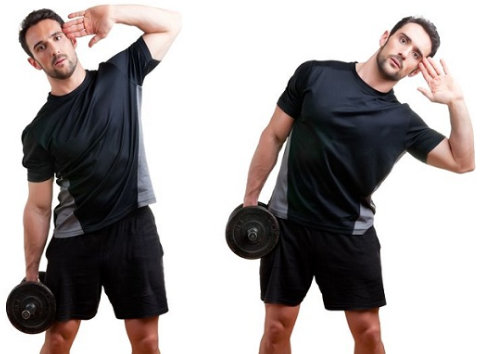
HYPOPRESSIVE AND STATIC ABDOMINAL EXERCISES
This post would be incomplete if we do not talk about hypopressive and static abdominal exercises. The abdominal machines and conventional exercises that we have seen go very well to strengthen the muscles of the six-pack and develop the tablet.
However, the ones we are going to see now are the great forgotten ones in core training. Hypopressive and static exercises are very important, as they have the function of keeping the abdominal core well attached to the spine.
Having the abdominal girdle well fixed to the spine will prevent injuries when performing other exercises, as our own abdominals will act as a protective belt. In addition, we will greatly improve our body posture. And aesthetically, our belly will look flatter.
Although from the outside we only see the external part of our abdominal core (the little squares of the tablet), inside we also have abdominal muscles responsible for keeping the core attached and stable.
Not training them can cause an imbalance and even an aesthetic result that is not expected (that your abs are sagging in the form of "belly").
To correct or avoid this, always perform exercises like the ones you are going to see below.
ABDOMINAL VACUUM TECHNIQUE: you will appreciate doing this simple exercise every day, which will not take you more than 5 minutes. But your abdominal wall will become much stronger and your abdomen will look flatter.
1.- Start with your arms as shown in the picture (you can lean on something if you want). Take a breath and hold your abs in.
2.- Now, mentally you will have to concentrate on pulling your abs in and up while releasing the air. Hold the position for 30 seconds (every 5 seconds, you have to refocus and squeeze your abdomen inward and upward as much as you can. This will prevent you from relaxing the muscles during the exhalation of air).
3.- Perform about 5 sets of 30 seconds every day.
This exercise can also be done sitting (even while driving or working in the office).

With this exercise you will maintain a strong abdominal wall, you will reduce some centimeters of waist and your belly will look flatter. Do these hypopressive abdominal exercises frequently.
THE PLANK: is a static exercise, widely used in the army. Easy to do at home.
1.- You just have to stand with the tips of your feet and forearms on the floor, with your body completely straight, as in the photo.
2 .- Take a breath and keep the abdomen tucked inward and tight.
3.- With each exhalation of air we mentalize to push our abdomen upwards keeping the body straight.
Hold the position for 30-60 seconds.
We can do several series of this exercise. We can increase the time we hold the plank position to progress in the exercise.
Performing the plank frequently will also strengthen your abdominal wall, improve your posture and give you a flat and defined abdomen.
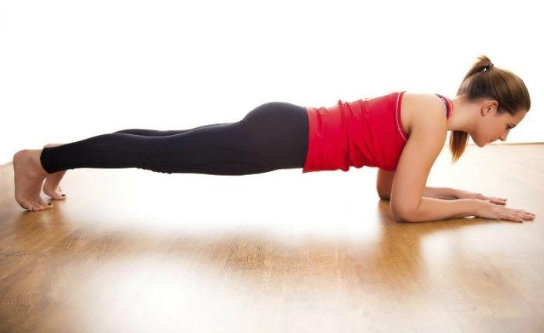
You can also perform the plank by localizing the work on the obliques, in this way:
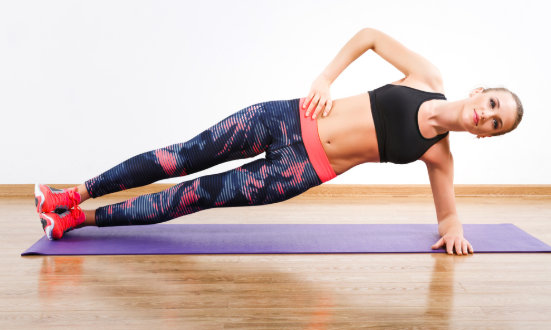
BODYBUILDING EXERCISES TO STRENGTHEN YOUR ABDOMINAL MUSCLES.
One of the best ways to develop a strong abdominal core is to perform bodybuilding exercises with free weights. The abdomen is worked and strengthened with most bodybuilding exercises, as the core is responsible for maintaining correct and compact posture during execution.
Here are some examples of the best exercises that strengthen the abdomen in a secondary way:
- PUSH-UPS / DIPS.
- DOUBLE DROP.
- DEAD WEIGHT.
- SITTING.
- BENCH PRESS.
- STANDING BICEPS CURL.
- STANDING MILITARY PRESS.
- BARBELL ROW.
REDUCE ABDOMINAL FAT
Rather it would be to reduce body fat, since abdominal fat will not go away unless we burn fat in general from all parts of the body.
Assuming that you have gone to the gym and have used for some time the machines we have recommended above, or you have trained at home with the exercises we have proposed. After a few months you should already have a strong and well formed abdominal core. If you still can't see your abs, it's because there is fat covering them.
In this case, the only thing left to do is to reduce body fat until the abdominal fat is gone and then uncover those abs that you have worked with the exercise.
HOW DO I REDUCE MY BODY FAT?
Well, the natural way to do this is to expend more calories than you take in over time. This has been proven and supported by the scientific community: evidence tells us that when the body is deprived of part of the calories it needs to perform its daily functions and activities, it will draw on stored fat reserves for energy.
Now, how can we provoke this caloric expenditure so that our organism begins to consume the fat reserves? Well, there are only two ways:
1.- Hypocaloric diet: you can reduce the calories you consume through diet. Eat clean and natural foods. The less processed, the better. Progressively reduce the amount of food consumed throughout the day and check month by month if you are losing weight. If you lose weight and your waist measures less, you are doing well. Always make sure that the diet is balanced and includes everything, because a hypocaloric diet is usually restrictive and we will feel lacking in energy until we get used to it.
What happens if I want to mark my abs but do not want to diet? In that case, you will have to increase your physical activity and exercise to provoke that caloric expenditure. The ideal is to combine both things, but if you eat the same thing habitually and increase your activity level, in the end your body will end up resorting to fat reserves due to that extra caloric requirement that has not been covered with food.
2.- Activity / physical exercise: increase the amount of exercise you do to force the body to expend calories. It can be any sport in which you have to move. Walking to places, jogging, skipping rope, boxing, etc.
Walk 1 hour daily every day of the week, and after 3-4 months you will have considerably reduced your body fat levels.
HOW LONG WILL IT TAKE ME TO GET MY ABS IN SHAPE WITH EXERCISE?
This is not a one-answer question. It will vary from person to person depending on their genetics and circumstances. We estimate that for the average male the time is usually about 3 months of dieting or exercise (or both) to get a six-pack.
But, as we explained at the beginning, this is taking as an example a person who is already at his ideal weight or just a few kg above (20% fat, for example).
For people who are significantly overweight, this process will obviously take much longer than those 3 months. In these cases, it is best to first remove all the excess fat until you are at your ideal weight. Then, give the diet a break. And then, if you still have the desire and motivation, continue to eliminate the remaining fat until you reach your six-pack.
DON'T FORGET TO INCLUDE BODYBUILDING EXERCISES
Something that many people do not take into account, especially if they have never before tried to mark the abs..., is that this process usually involves staying at a fairly low body weight. Especially if you didn't have a certain muscle base underneath the fat, which is usually the case for many people.
Fat takes up a lot of space and it also weighs. In other words, to lose fat we will have to lose body weight.
As we mentioned at the beginning, an average man with 20% fat will probably have to lose 8-10 kg of weight to have well-defined abs.
|
|
Actor Bruce Lee: 171 cm, 60 kg weight. | Actor Brad Pitt in "Fight Club". 180 cm and 70 kg weight. |
We tend to underestimate the amount of actual fat we have. That's the reality. Achieving the coveted six pack, especially if we didn't have a good overall muscle base, involves getting pretty lean. At least if it is done naturally (without doping substances). That's why it is important to include bodybuilding exercises during this process (you don't necessarily have to go to the gym).


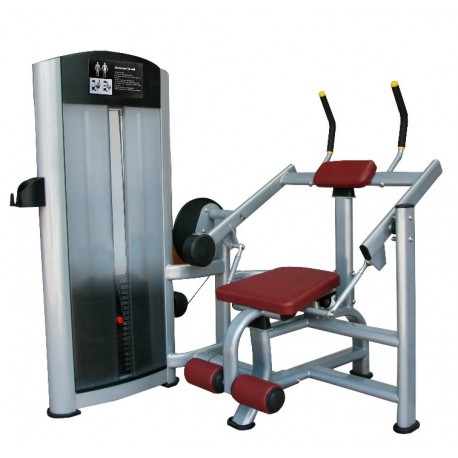
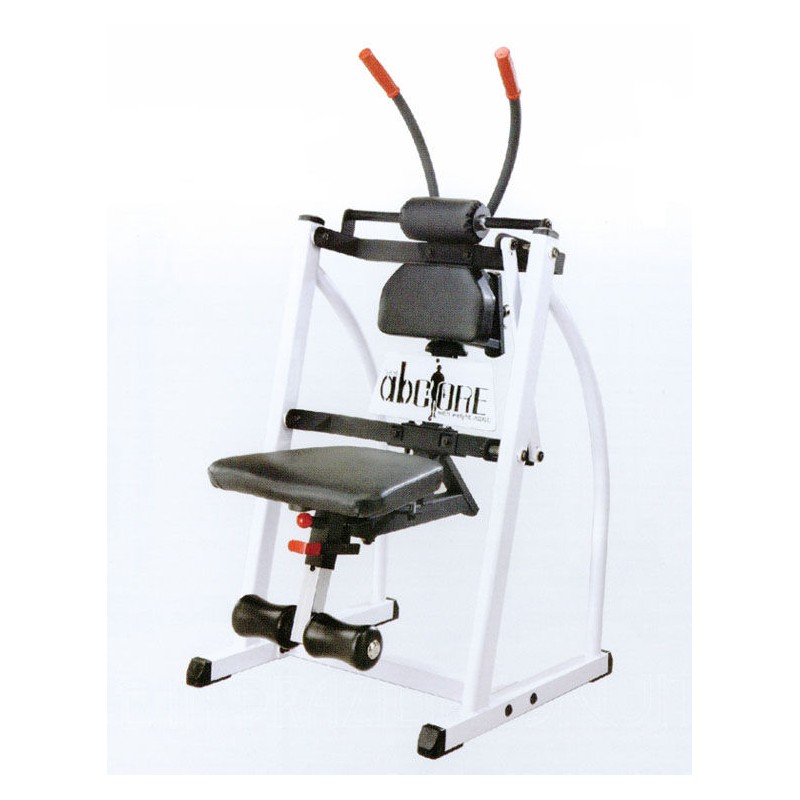
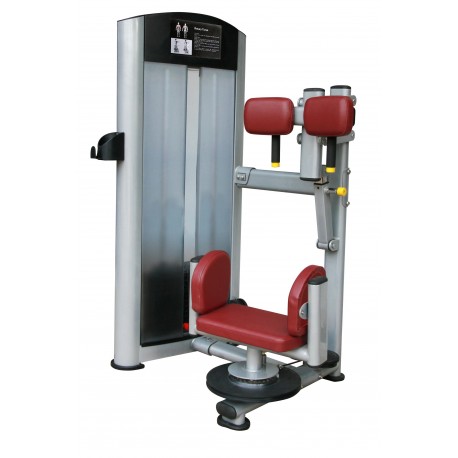
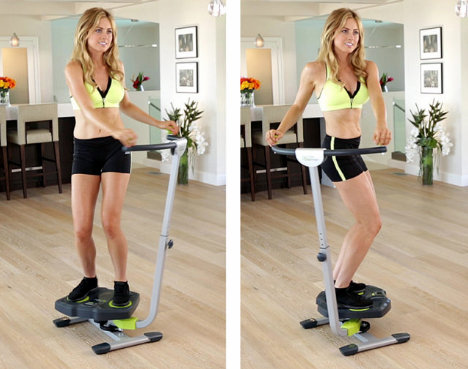
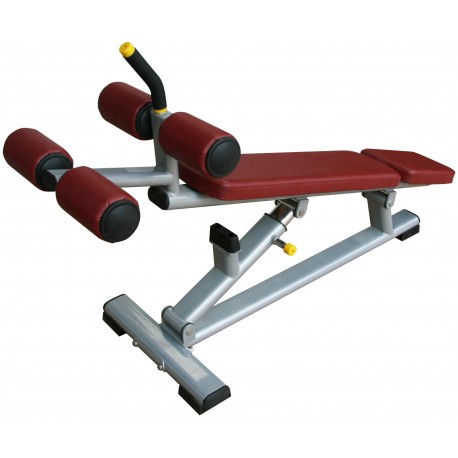
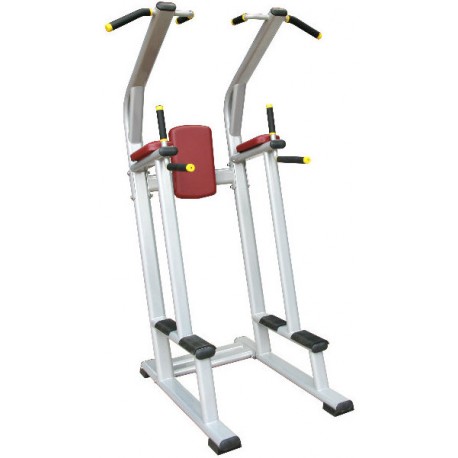
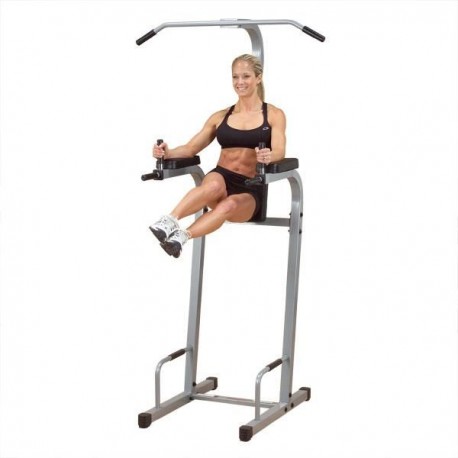
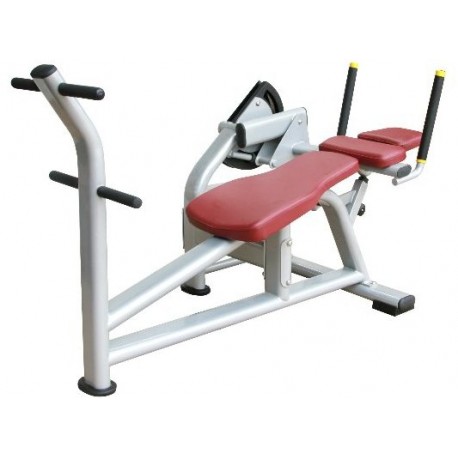
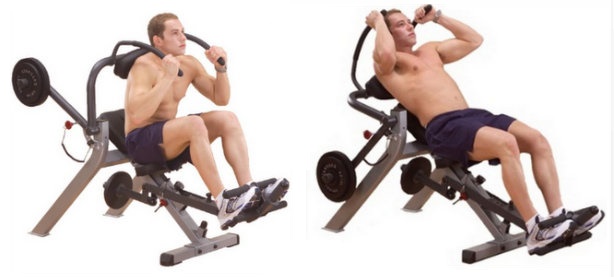
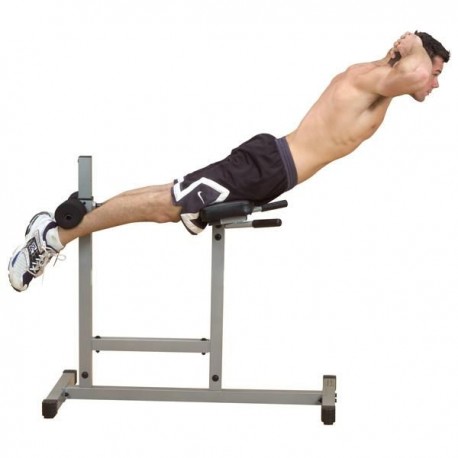
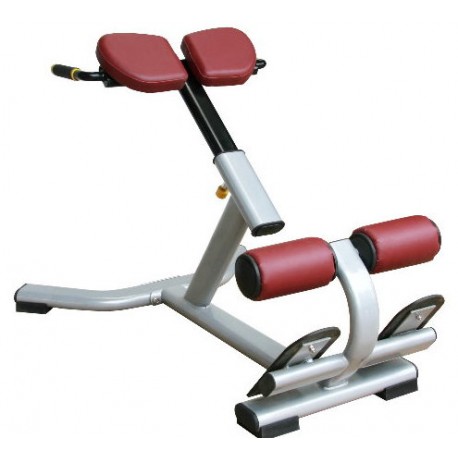
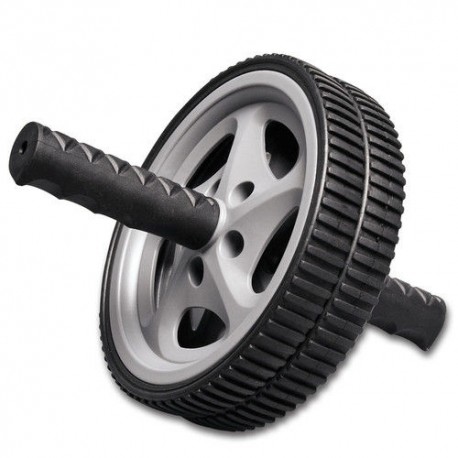
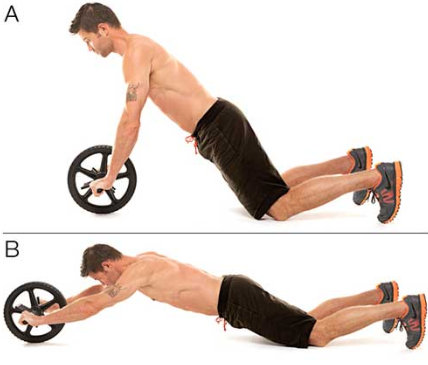
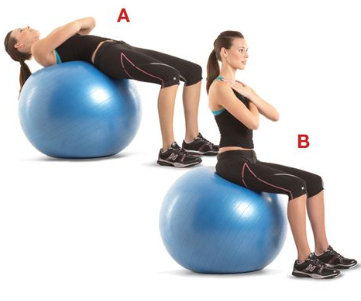
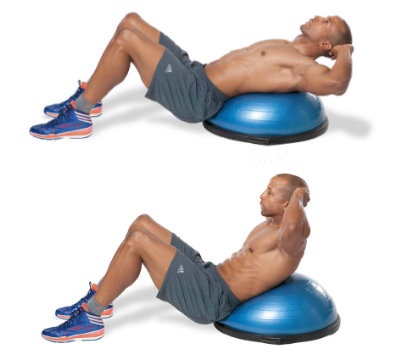
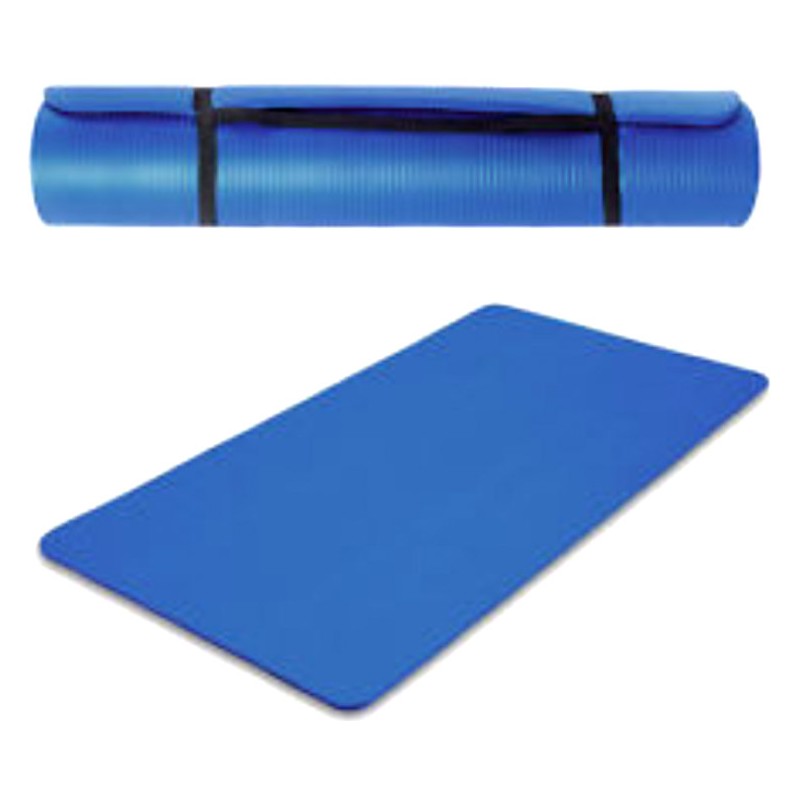
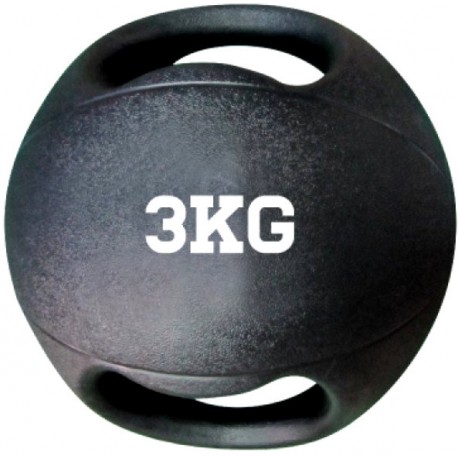
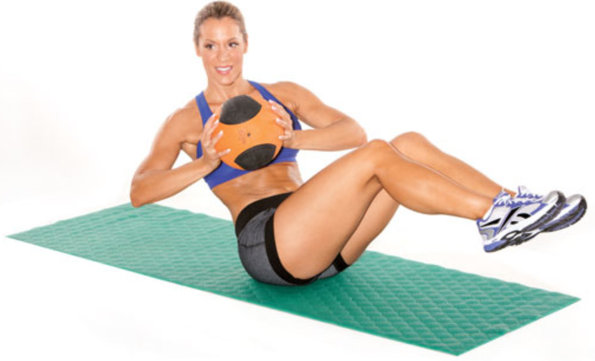
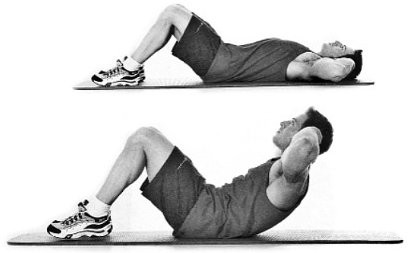
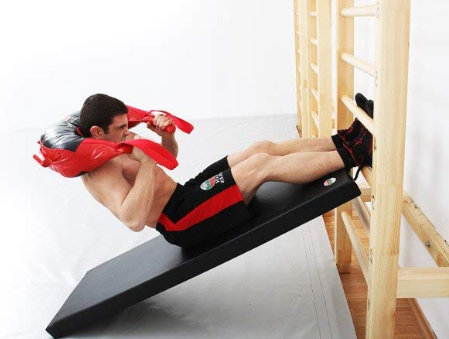
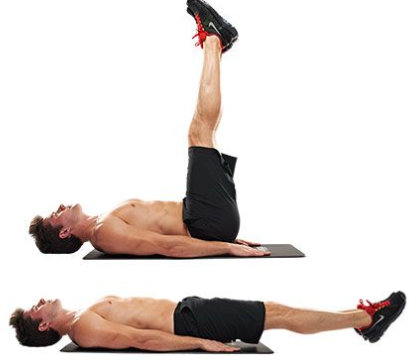
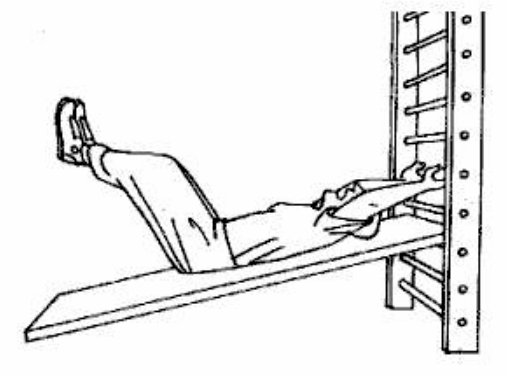
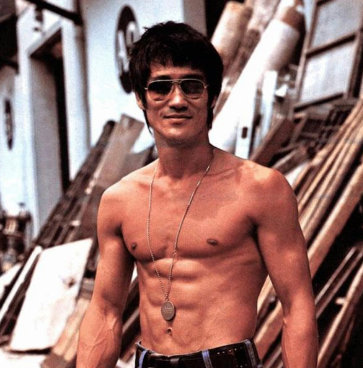









Muy buen articulo, siempre es buenos mantenerse saludable para llevar un mejor estilo de vida tanto fisico como mental y este tipo de informacion es muy valiosa , gracias por compartir